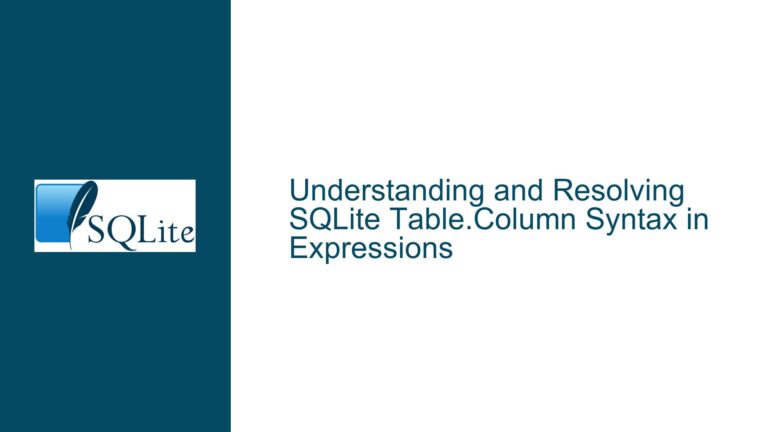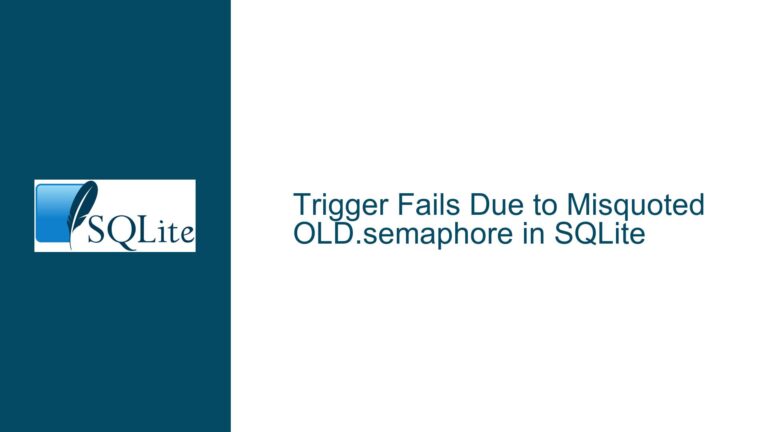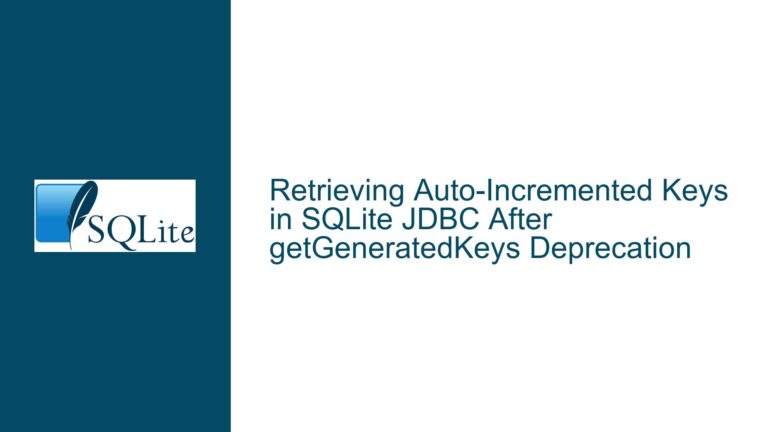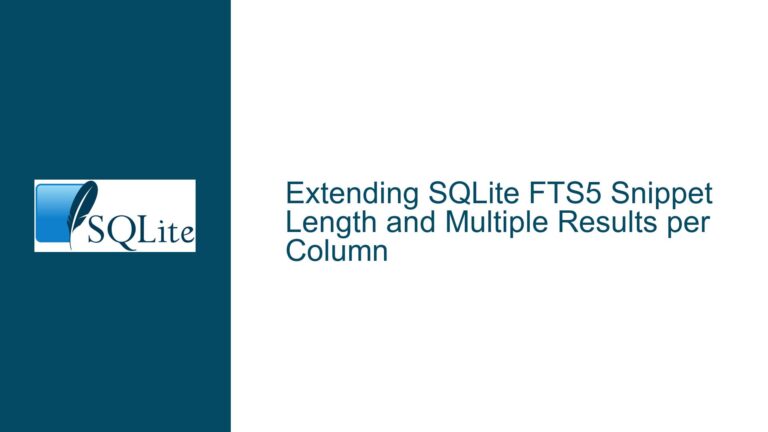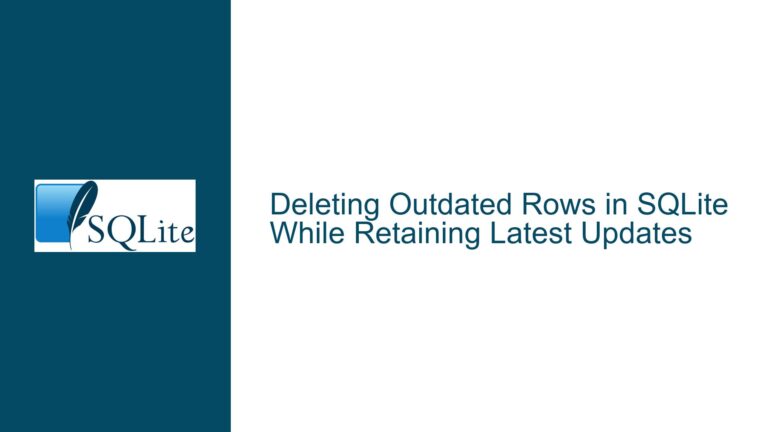Selecting All Paths and Files Without Duplicate Path Entries in SQLite
Structuring Hierarchical Data Retrieval with Path and File Associations
When working with relational databases like SQLite, a common challenge arises when attempting to retrieve hierarchical data from multiple tables while avoiding redundant parent record repetition. This guide addresses the specific scenario where users need to retrieve all columns from both a parent table (Paths) and child table (Files), while ensuring each path record appears only once in the output, followed by all associated files. This structure mimics directory listings where folder headers precede their contained files.
Core Challenge: Hierarchical Output with Complete Column Sets
Problem Statement
The database contains two tables:
- Paths: Stores directory metadata (e.g.,
pathid,path, timestamps, ownership). - Files: Stores file metadata (e.g.,
fileid,pathidforeign key,fname,fsize, file type).
A standard JOIN between these tables produces redundant path entries:
pathid | path | fileid | fname
-------------------------------------
1 | /home/docs | 100 | report.pdf
1 | /home/docs | 101 | notes.txt
Desired Output:
pathid | path | (other Paths columns)
--------------------------------------------
1 | /home/docs | ...
fileid | fname | (other Files columns)
--------------------------------------------
100 | report.pdf | ...
101 | notes.txt | ...
Each path appears once, followed by its files. All columns from both tables must be included without aggregation (e.g., GROUP_CONCAT), which collapses file data into a single field.
Technical Constraints
- SQLite lacks native hierarchical result sets.
- Output must preserve all columns from both tables.
- Paths without files must still appear.
Root Causes of Redundant Path Entries
Join Mechanics
INNER JOINorLEFT JOINbetweenPathsandFilesinherently replicates path rows for each matching file. This is standard relational behavior but conflicts with the desired presentation format.Result Set Structure
SQL queries return uniform rows with fixed columns. Hierarchical grouping (path header + child files) isn’t natively supported, necessitating creative workarounds.Column Count Mismatch
PathsandFileshave differing columns, complicatingUNIONoperations. Padding withNULLor placeholders is required to align column sets.Ordering Requirements
Paths and their files must be ordered sequentially. Achieving this requires explicit sorting logic, often involving composite keys or window functions.
Solutions for Hierarchical Data Presentation
Approach 1: Union with Column Padding and Ordering
Step 1: Align Column Sets
Use UNION ALL to combine Paths and Files records, padding missing columns with NULL or empty strings.
Example Query:
SELECT
'Path' AS record_type,
pathid,
path,
uid AS path_uid,
atime AS path_atime,
mtime AS path_mtime,
ctime AS path_ctime,
NULL AS fileid,
NULL AS fname,
NULL AS inode,
NULL AS fsize,
NULL AS file_uid,
NULL AS file_atime,
NULL AS file_mtime,
NULL AS file_ctime,
NULL AS type
FROM Paths
UNION ALL
SELECT
'File' AS record_type,
p.pathid,
p.path,
p.uid AS path_uid,
p.atime AS path_atime,
p.mtime AS path_mtime,
p.ctime AS path_ctime,
f.fileid,
f.fname,
f.inode,
f.fsize,
f.uid AS file_uid,
f.atime AS file_atime,
f.mtime AS file_mtime,
f.ctime AS file_ctime,
f.type
FROM Files f
LEFT JOIN Paths p ON f.pathid = p.pathid
ORDER BY pathid, record_type DESC;
Key Adjustments:
record_type: Differentiates path/file rows. SortingDESCensures "Path" precedes "File" entries.- Explicit Aliasing: Distinguishes columns shared between tables (e.g.,
uid, timestamps). - NULL Padding: Fills absent columns in
PathsorFilessubsets.
Output:
record_type | pathid | path | path_uid | ... | fileid | fname
---------------------------------------------------------------------
Path | 1 | /home/docs | 1000 | ... | NULL | NULL
File | 1 | /home/docs | 1000 | ... | 100 | report.pdf
File | 1 | /home/docs | 1000 | ... | 101 | notes.txt
Application-Level Handling:
Process the result set iteratively:
- When
record_type = 'Path', display path metadata. - For subsequent
'File'rows with the samepathid, display file details without repeating path data.
Approach 2: Window Functions for Row Numbering
For SQLite versions ≥ 3.25 (with window function support), use ROW_NUMBER() to identify the first file per path and conditionally display path data.
Example Query:
SELECT
CASE WHEN row_num = 1 THEN p.pathid ELSE NULL END AS pathid,
CASE WHEN row_num = 1 THEN p.path ELSE NULL END AS path,
CASE WHEN row_num = 1 THEN p.uid ELSE NULL END AS path_uid,
CASE WHEN row_num = 1 THEN p.atime ELSE NULL END AS path_atime,
CASE WHEN row_num = 1 THEN p.mtime ELSE NULL END AS path_mtime,
CASE WHEN row_num = 1 THEN p.ctime ELSE NULL END AS path_ctime,
f.fileid,
f.fname,
f.inode,
f.fsize,
f.uid AS file_uid,
f.atime AS file_atime,
f.mtime AS file_mtime,
f.ctime AS file_ctime,
f.type
FROM (
SELECT
f.*,
ROW_NUMBER() OVER (PARTITION BY f.pathid ORDER BY f.fileid) AS row_num
FROM Files f
) f
LEFT JOIN Paths p ON f.pathid = p.pathid
UNION ALL
-- Include paths without files
SELECT
p.pathid,
p.path,
p.uid,
p.atime,
p.mtime,
p.ctime,
NULL, NULL, NULL, NULL, NULL, NULL, NULL, NULL, NULL
FROM Paths p
WHERE NOT EXISTS (
SELECT 1 FROM Files f WHERE f.pathid = p.pathid
)
ORDER BY pathid, row_num;
Output Logic:
- The first file in each
pathidpartition includes path metadata. Subsequent files showNULLfor path columns. - Paths without files are appended via
UNION ALL.
Application Handling:
Iterate through results:
- When path columns are non-
NULL, render a new path header. - Display file rows under their last encountered path.
Approach 3: Hybrid SQL and Application Logic
For large datasets, minimize data transfer by fetching paths and files separately and merging them programmatically.
Step 1: Retrieve Paths
SELECT * FROM Paths ORDER BY pathid;
Step 2: Fetch Files Grouped by Path
SELECT
p.pathid,
f.*
FROM Files f
LEFT JOIN Paths p ON f.pathid = p.pathid
ORDER BY p.pathid, f.fileid;
Application Logic (Pseudocode):
paths = execute("SELECT * FROM Paths ORDER BY pathid")
files = execute("SELECT p.pathid, f.* FROM Files f JOIN Paths p ...")
current_path = None
for row in files:
if row.pathid != current_path:
current_path = row.pathid
print(paths[current_path]) # Display path header
print(row.file_data) # Display file details
Advantages:
- Redundant path data isn’t transferred.
- Simplifies SQL complexity.
Optimization Considerations
Indexing:
EnsureFiles.pathidis indexed to accelerate joins:CREATE INDEX idx_files_pathid ON Files(pathid);Query Planning:
UseEXPLAIN QUERY PLANto analyze joins and avoid full table scans.Pagination:
For large datasets, limit results usingLIMITandOFFSET, fetching paths and files in chunks.
Conclusion
Achieving hierarchical output in SQLite requires balancing SQL capabilities with application logic. While pure SQL solutions exist via UNION and window functions, combining targeted queries with programmatic processing often yields the most efficient and maintainable results. Developers should evaluate trade-offs between SQL complexity, data transfer volume, and application handling to choose the optimal approach for their use case.

